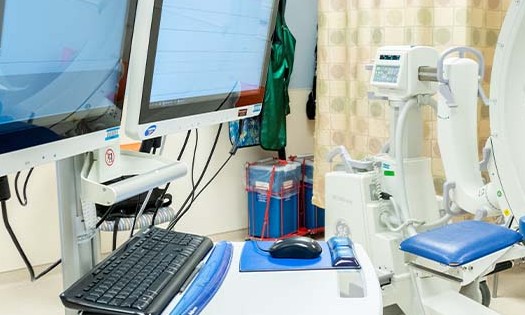Urodynamics testing can be valuable for evaluating pediatric urological problems, but it can be overused and typically isn’t necessary for common issues such as urinary urgency, leaking or nighttime incontinence.
Craig Peters, M.D., and his colleagues at Children’s Health℠ – one of the nation’s highest-volume pediatric urology centers – are eager to share insights on when urodynamics testing is appropriate, and on noninvasive alternatives that can deliver valuable information.
“Symptoms like incontinence can be the manifestation of anything from a complicated neurological problem to a bladder obstruction to a simple behavioral pattern,” says Dr. Peters, Division Director of Pediatric Urology at Children’s Health and Professor of Urology at UT Southwestern. “It can be tempting to turn to urodynamics early, but it’s invasive and not always appropriate, so I think it helps everyone to have a clearer sense of their options for evaluating urological issues.”
Strategies for Evaluating Common Urological Problems
Our urology team receives requests for urodynamic testing for incomplete emptying, urinary urgency, leaking and bedwetting. For children with these common problems, says Dr. Peters, old-fashioned inference can help solve many diagnostic puzzles – without subjecting a child to a long and uncomfortable test.
Incomplete emptying can have a neurological basis or a structural cause such as a bladder sphincter that doesn’t properly relax. But it can also be caused by behaviors, such as a child tightening their pelvic floor to stop urinating because they want to keep playing.
Our team recommends starting with a careful history.
“That can help you dissect whether the issue is functional and can be unlearned, or whether it’s a potential structural or neurological issue that would warrant further testing,” Dr. Peters says.
When a child has urgency and leaking, Dr. Peters recommends starting the child on a low dose of an anticholinergic. If that significantly improves the symptoms, it can be a reliable indicator of an overactive bladder.
“If you don’t suspect a significant underlying issue, this can be a good way to get to a diagnosis without putting the child through urodynamics,” Dr. Peters says.
For children with bedwetting and other incontinence, Dr. Peters recommends first screening for daytime symptoms. He also advises evaluating their habits and medical history, to detect whether they drink excess fluids or caffeine, or take medications that can trigger incontinence.
“These children almost never need urodynamic testing,” Dr. Peters says. “As long as you’re not worried that there is a potentially damaging problem, our recommendation is to try certain medications or behavior modifications and see if you get improvement.”
The Value of Physical Exams
Dr. Peters also stresses that a careful physical examination can reveal important clues that can indicate when urodynamics may be needed.
With some urinary problems or significant constipation, for example, Dr. Peters encourages providers to look for problems with gait and lower-extremity control that could indicate spinal cord abnormalities.
“We also encourage providers to look at the child’s lower spine because some of these conditions are related to abnormalities of the sacral spine. Either it won't look symmetrical, it might have a hairy patch or there might be a subtle change in the skin,” Dr. Peters says.
Physical exams that detect these features could lead to a diagnosis of spina bifida or other neurological issues – before they lead to bladder dysfunction that damages the kidney. These children will often need to have a urodynamic assessment to clearly define the nature and severity of their condition.
Noninvasive Testing Options
If wetting or urgency issues continue despite medical and behavior management, our team can offer an array of noninvasive tests that enables us to diagnose and treat a majority of patients without catheterization. Dr. Peters and his colleagues often turn to a noninvasive flow electromyography (EMG) test. This test measures the electrical activity of the pelvic floor, and evaluates whether it’s properly coordinated with a child’s urine flow.
“We use flow EMG quite a lot,” Dr. Peters says. “It can show us if the child’s voiding patterns are normal or abnormal, because the pelvic floor should relax when the bladder starts to contract as you urinate.”
If our team detects an imbalance, they will often pursue medical management such as using a bladder or pelvic floor relaxant. In some cases biofeedback may be necessary and appropriate to help the child re-learn healthy pelvic floor behavior.
“Flow EMG is simpler and a lot more comfortable than full urodynamics, and it shows how you can gather a lot of information without putting a child through catheterization and X-rays,” Dr. Peters says.
When to Turn to Urodynamics
Still, there are many scenarios when urodynamics is appropriate and useful. Generally speaking, our team turns to urodynamics if:
They see signs of a potentially significant underlying issue that could pose a risk to the bladder or kidney. These signs include kidney dilation and/or a bladder that looks abnormal on ultrasound.
Medical management and/or behavioral modification don’t improve the child’s symptoms.
The child experiences recurrent infections or ongoing, severe constipation.
There is evidence of a neurological problem affecting the bladder and pelvic floor.
“In those cases, you need a more detailed picture of any potential structural cause, because your treatment may need to be very different than what you’ve tried,” Dr. Peters says.
He also notes that urodynamics doesn’t always reveal an underlying cause, but can still be useful because it excludes serious underlying conditions.
“It rules out some treatments and provides information that can both guide therapy and serve as a baseline for follow up,” Dr. Peters says.
Simple Guidelines to Consider for Urodynamics
Dr. Peters recognizes the temptation to turn to urodynamics, especially when parents are eager to confirm a diagnosis or get a clearer picture of a condition’s severity. He also understands that using urodynamics in children can be opaque to providers who don’t use the test often or don’t treat a significant number of pediatric patients. That’s why he and his colleagues regularly offer courses to teach providers about urodynamics, and why he embraces a few simple guidelines.
“I always try to stop and consider the invasiveness of the test, whether it will yield a result that could change my management approach, and also the cost,” Dr. Peters says. “Then I’ll go ahead with urodynamics if I know I really need it, if I’m clear on what I’m going to learn, and if I know how that information will help me care for the child.”
Learn more about our latest urology insights and advances >>


